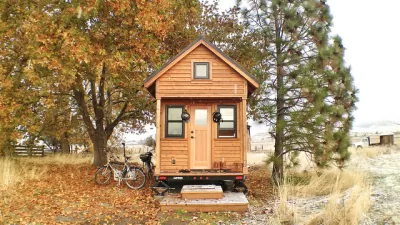Building sizes have been creeping upward for centuries, but green building expert Jason McLennan argues that smaller structures are better, more beautiful, and ecologically inevitable.
Throughout history, empires have been scaling up their building sizes in order to reflect their power. In modern times, we build oversize buildings to match our oversize corporations, "mega-metropolises," and economies.
But Jason McLennan argues that this can't go on forever. "There is a point where individual accountability, familiarity, and sense of place disappear. And we have reached it," he writes. "We have lost the ability to relate to and understand our food systems, economic systems, energy and transportation systems, and ultimately the environment itself."
McLennan believes that we'll necessarily return to a sustainable scale of building and living within the next 20 years. He predicts that our skyscrapers will shrink, we'll start to live more locally, and start learning to know the land and communities again. "The only oversized movement we need is the one that takes us closer to small, localized solutions."
There's no single right size for buildings or communities, he says, but the key is to find the "sweet spot" for any initiative and he includes a number of tests of scale for identifying it.
FULL STORY: In the Built Environment, the Tyranny of the Big, the Beauty of the Small

Planetizen Federal Action Tracker
A weekly monitor of how Trump’s orders and actions are impacting planners and planning in America.

Maui's Vacation Rental Debate Turns Ugly
Verbal attacks, misinformation campaigns and fistfights plague a high-stakes debate to convert thousands of vacation rentals into long-term housing.

Restaurant Patios Were a Pandemic Win — Why Were They so Hard to Keep?
Social distancing requirements and changes in travel patterns prompted cities to pilot new uses for street and sidewalk space. Then it got complicated.

In California Battle of Housing vs. Environment, Housing Just Won
A new state law significantly limits the power of CEQA, an environmental review law that served as a powerful tool for blocking new development.

Boulder Eliminates Parking Minimums Citywide
Officials estimate the cost of building a single underground parking space at up to $100,000.

Orange County, Florida Adopts Largest US “Sprawl Repair” Code
The ‘Orange Code’ seeks to rectify decades of sprawl-inducing, car-oriented development.
Urban Design for Planners 1: Software Tools
This six-course series explores essential urban design concepts using open source software and equips planners with the tools they need to participate fully in the urban design process.
Planning for Universal Design
Learn the tools for implementing Universal Design in planning regulations.
Heyer Gruel & Associates PA
JM Goldson LLC
Custer County Colorado
City of Camden Redevelopment Agency
City of Astoria
Transportation Research & Education Center (TREC) at Portland State University
Jefferson Parish Government
Camden Redevelopment Agency
City of Claremont



























